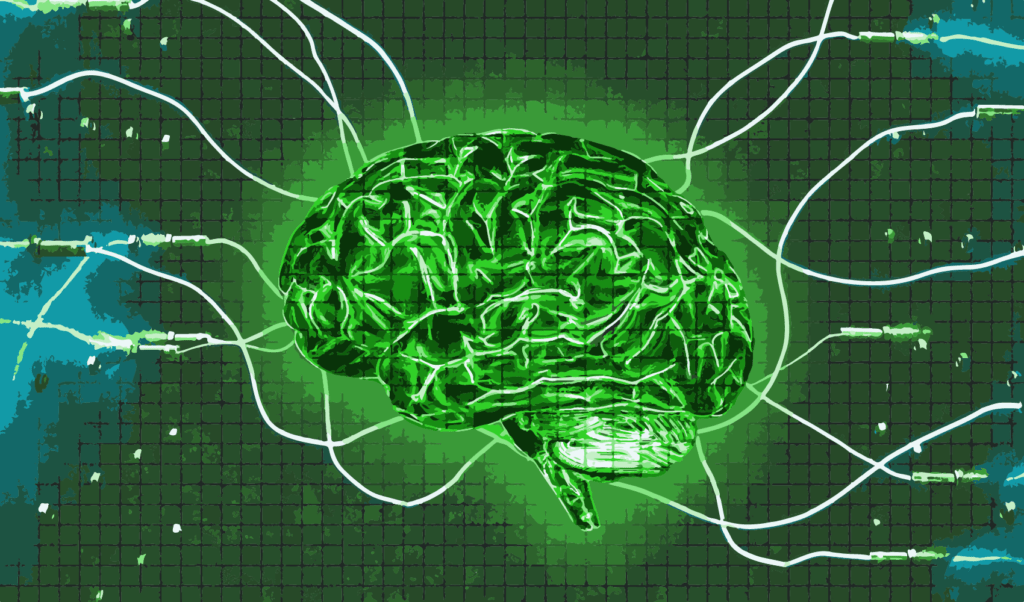We use cookies to improve your experience with Monash. For an optimal experience, we recommend you enable all cookies; alternatively, you can customise which cookies you’re happy for us to use. You may withdraw your consent at any time. To learn more, view our Website Terms and Conditions and Data Protection and Privacy Procedure.
Brain-machine interfaces
Published on September 26, 2022360info is looking into how far brain-machine interface research has come and what is currently at the forefront of science and technology.
 Brain-machine interface technology connects the brain directly to machine intelligence. : Michael Joiner, 360 info CC BY 4.0
Brain-machine interface technology connects the brain directly to machine intelligence. : Michael Joiner, 360 info CC BY 4.0
360info is looking into how far brain-machine interface research has come and what is currently at the forefront of science and technology.
The idea that brains can control computers may seem like science fiction, but it’s becoming closer to our reality. Brain-machine interfaces, also commonly known as brain-computer interfaces, decode electrical information from your brain and connect it to an external device.
It has a wide variety of potential uses but has been particularly valuable in restoring human mobility and aiding people with disabilities. These include allowing people to control prosthetic limbs with their minds.
In July, brain-computer start-up Synchron placed the first implant in the US. The 3.8 centimetre device was placed into the blood vessel of an ALS patient who had lost their ability to move and speak.
“This is an incredibly exciting milestone for the field, because of its implications and huge potential,” said Shahram Majidi, the lead clinical investigator who performed the procedure.
“The implantation procedure went extremely well, and the patient was able to go home 48 hours after the surgery.”
It’s hoped the patient will be able to use the internet to shop online, communicate via email or text using his mind. The company has already begun trials in Australia.
Most brain-machine systems are still experimental. Our brains are one of the most complicated organs. While a brain can be compared to a very advanced computer, we’re still unable to successfully recreate one in its entirety.
And there are also issues of ethics, legal and security concerns.
Cyberattacks and hackers could intercept brain signals and use information maliciously. The high costs of the product are likely to result in unequal distribution.
The technology could be used for military purposes. For example, the US Department of Defense has invested in hands-free control of drones. Although still a long way to go, in the wrong hands, it could pose significant national security concerns.
REALITY CHECK
US-based Irish scientist Philip Kennedy implanted the first brain-machine interface on the human brain in 1998.
The purpose of brain-machine interfaces have largely been medically related.
They are often categorised as either invasive (requiring surgery), or non-invasive (commonly from data gathered through an EEG).
Non-invasive brain-machine interfaces often require a wearable cap using conductors to measure the brain’s electrical activity.
Last year, a wireless headset to help stroke patients regain arm and hand movements became the first wearable brain-machine interface device allowed by the government to be sold commercially in the US.
BIG IDEAS
This quote is attributable to Jared Genser, Georgetown University Law Center:
“Other technology uses algorithms to extrapolate and collect data on users’ personal preferences and location, but brain-machine interfaces offer something completely different: they can directly connect the brain to machine intelligence.”
“Brain-machine interfaces pose challenges not only for the privacy of our minds, but also for our sense of self and for free will.”
“The rise of consumer neurotechnology emphasises the need for laws and regulations that reflect the technology’s advancement.”
This quote is attributable to Miguel Nicolelis, Duke University:
“Information in the brain is not digital. It’s embedded in the tissue. And so there’s no vacuum cleaner that’s going to get that from analogue organic tissue and put it into bites and bits in your brain. Your brain is not a hard disk. It’s not a computer.”
This quote is attributable to Raphael Yuste, Colombia University:
“We’ll finally figure out who we are. Why do we do what we do? Why are we happy? Why are we sad? What happens when we fall in love. What happens to a criminal when he commits a crime? So it has enormous repercussions through, because, again, our our species happens to be a species that is a mental species. Everything has to do with our our mind.”
Originally published under Creative Commons by 360info™.










